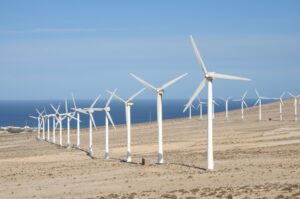
By:Justicia Shipena
Namibia has a world-class wind energy potential along its southern and northern coasts with wind capacity factors of about 56 to 58 percent, according to Namibia’s green hydrogen project strategy.
Last week, Namibia’s Green Hydrogen Council launched its green hydrogen strategywhich supports the country’s commitment to the Paris Agreement on climate change, with the ultimate goal of reducing emissions to net zero by 2050.
The strategy report says the wind energy potential is much higher than other potential exporters like Australia and South Africa which average less than 40%.
The strategy shows that Namibia’s unique mix of wind and solar resources could provide a stable supply of very low-cost, clean power for hydrogen production.
“Combined, these resources could enable Namibia to achieve a levelised cost of hydrogen (LCOH) of just US$1.2-1.3/kg for production by 2030, if no specific firmness level is required7. Derivative production can require higher levels of firmness, resulting in a 25% increase of LCOH to about US$1.5-1.6 / kg hydrogen in 2030,” states the document.
According to the Council, this outperforms expected green hydrogen production costs in Morocco and Saudi Arabia.
Meanwhile, ranked 141 as a contributor to global emissions in 2020, Namibia has set a goal to reduce its greenhouse gas emissions by 91% by 2030 with the implementation of an ambitious green hydrogen project.
Reads the strategy document: “It (Namibia) aspires to use its own natural resources to support the global transition to net-zero and deliver socio-economic benefits to its people in the form of broadly shared prosperity.”
Furthermore, the country is set to emerge as a major global hydrogen producer and an early entrant in the hydrogen export market, focusing on the export of hydrogen derivatives including ammonia, methanol, synthetic kerosene and hot-briquetted iron.
“Namibia is expected to have some of the lowest hydrogen production costs in the world,” states the document.
“Transporting hydrogen over long distances and the losses incurred through the compression or liquefaction process make exporting pure hydrogen uncompetitive for most of Namibia’s potential key markets.”
However,the Council reckons that more energy-dense derivatives of hydrogen can be exported at lower transport costs through an already existing infrastructure.
The strategy further states that by 2030, the country’s ammonia production costs could fall from US$420-460 per ton to US$320-360 per ton by 2050.
Other factors that make Namibia favourable to the development of an at-scale hydrogen hub is its renewable resources are coastal, ensuring a sustainable and low-cost water supply through desalination for electrolysis.
“They are close to ports, in particular in the !Kharas and Erongo regions. And the Government owns and can lease large amounts of land that is readily available thanks to the low population density.”
Meanwhile, Namibia is looking to develop supplier relationships with Europe, Japan, South Korea, and China and it added that it is open to discussing opportunities with other regions.
Furthermore, the strategy report also showed that Namibia is not the lowest-cost provider in Asia but it is a leading green producer.
“Therefore, it (Namibia) aims to be part of the diversified supplier base needed when the security of supply becomes a concern and countries do not want to rely on a single supplier. Namibia could start delivering ammonia to Japan and South Korea if they scale up their hydrogen economies while domestic production cannot meet demand, and if Japan’s regulatory target of decarbonized ammonia for power by 2030 remains in place.”
President Hage Geingob says building a thriving hydrogen industry in Namibia has the potential to make a major contribution to solving the global climate crisis.
Geingob also invited the public and private sectors to hop onto the boat, stressing that the time to act on climate change is now.
“Namibia plans to respond accordingly. We, therefore, invite like-minded partners, public and private, to join us as we embark on an exciting and transformative journey to reshape the global energy and industrial landscapes into a more sustainable home for all mankind.”









Comments